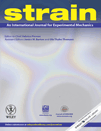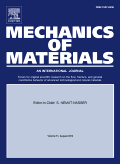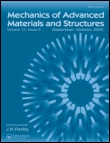
Extreme Mechanics Letters
Scope & Guideline
Unleashing Pioneering Research in Engineering
Introduction
Aims and Scopes
- Advanced Materials Mechanics:
The journal extensively covers the mechanics of new and advanced materials, including metamaterials, hydrogels, and bio-inspired materials, highlighting their unique properties and applications. - Multiscale and Multiphysics Modeling:
Research often involves multiscale modeling techniques that capture the behavior of materials from atomic to macroscopic scales, integrating various physical phenomena such as thermal, mechanical, and electromagnetic effects. - Interdisciplinary Approaches:
Extreme Mechanics Letters promotes research that crosses traditional boundaries, incorporating insights from physics, engineering, biology, and materials science to address mechanical challenges. - Innovative Experimental Techniques:
The journal features studies utilizing cutting-edge experimental methods, including in situ measurements, advanced imaging techniques, and novel fabrication processes to investigate mechanical phenomena. - Machine Learning and Data-Driven Approaches:
A significant focus is placed on the application of machine learning and data-driven approaches to predict material behavior, optimize designs, and enhance understanding of complex mechanical systems.
Trending and Emerging
- Metamaterials and Architected Materials:
There is a growing trend in the exploration of metamaterials and architected materials, focusing on their unique mechanical properties and potential applications in various fields such as acoustics and vibration control. - Machine Learning Applications:
The integration of machine learning techniques in mechanical design and analysis is increasingly prominent, indicating a shift towards data-driven methodologies for predicting material behavior and optimizing structures. - Bio-inspired and Soft Materials:
Research on bio-inspired designs and soft materials is gaining traction, reflecting a broader interest in materials that mimic natural systems for applications in soft robotics and flexible electronics. - Dynamic and Nonlinear Mechanics:
An uptick in studies addressing dynamic behavior and nonlinear mechanics is evident, as researchers seek to understand complex phenomena under various loading conditions. - Sustainable and Smart Materials:
Emerging themes also include the development of sustainable materials and smart systems that respond adaptively to environmental stimuli, aligning with global trends towards sustainability.
Declining or Waning
- Traditional Material Mechanics:
There has been a noticeable decrease in papers focused solely on traditional material mechanics without the integration of advanced techniques such as machine learning or multiscale modeling. - Focus on Conventional Materials:
Research on conventional materials, such as standard metals and polymers, appears to be waning, as the journal increasingly emphasizes novel materials and innovative composites. - Static Mechanical Analysis:
Papers centered around static mechanical analysis are less frequent, with a shift towards dynamic, time-dependent behaviors and applications in real-world scenarios.
Similar Journals

Journal of Applied Mechanics and Technical Physics
Exploring the Dynamics of Material Science and EngineeringJournal of Applied Mechanics and Technical Physics is a distinguished publication that serves as a vital resource for researchers and professionals in the realms of mechanical engineering, mechanics of materials, and condensed matter physics. Published by MAIK NAUKA/INTERPERIODICA/SPRINGER, this journal has been committed to disseminating high-quality research since its inception in 1965. With a noted presence in the academic community, it holds a respectable Q3 ranking in multiple categories as of 2023, indicating its relevance and contribution to the field. Although it does not currently offer open access, the journal provides valuable insights and advancements through its rigorous peer-review process. Covering a broad spectrum of topics in applied mechanics and technical physics, it aims to foster innovation and dialogue among scientists, engineers, and scholars alike. Located in the United States, the journal continues to make significant strides in bridging the gap between theoretical research and practical applications, making it an essential read for anyone engaged in these dynamic fields.

International Journal of Advances in Engineering Sciences and Applied Mathematics
Bridging Engineering and Mathematics for Tomorrow's SolutionsInternational Journal of Advances in Engineering Sciences and Applied Mathematics, published by SPRINGER INDIA, is a distinguished journal dedicated to advancing research in the fields of engineering sciences and applied mathematics. With a focus on innovative methodologies and applications, the journal provides a platform for researchers, professionals, and students to disseminate their findings and explore new frontiers in engineering and mathematical sciences. The journal seeks to publish high-quality, peer-reviewed articles that address contemporary challenges and promote interdisciplinary collaboration. While currently not an open-access publication, it remains a significant resource for those in academia and industry, fostering a deeper understanding of complex engineering problems through rigorous mathematical frameworks. The journal’s ISSN is 0975-0770, with an E-ISSN of 0975-5616, ensuring a broad dissemination of knowledge in the scientific community.

MECCANICA
Pioneering Insights in Engineering and MaterialsMECCANICA, an esteemed journal published by Springer, stands at the forefront of research in the fields of Condensed Matter Physics, Mechanical Engineering, and Mechanics of Materials. Established in 1966 and continuing through 2024, this journal provides a robust platform for the dissemination of innovative research and advancements in these increasingly interconnected domains. With an impressive 2023 ranking placing it in the Q2 category across multiple fields, MECCANICA boasts a Scopus rank of #198 in Mechanical Engineering, #150 in Condensed Matter Physics, and #141 in Mechanics of Materials, highlighting its significance and influence within the scholarly community. The journal aims to foster dialogue among researchers, professionals, and students, facilitating the exchange of cutting-edge ideas and methodologies crucial for overcoming contemporary engineering and physics challenges. Readers can access a wealth of knowledge through its comprehensive articles, and while it does not currently offer open access, the journal remains instrumental in shaping the future of engineering and physical sciences.

STRAIN
Transforming Understanding of Material BehaviorSTRAIN is a prestigious peer-reviewed journal published by WILEY, dedicated to advancing the field of mechanical engineering and mechanics of materials. With an ISSN of 0039-2103 and an E-ISSN of 1475-1305, STRAIN has been a pivotal resource for researchers and professionals since its inception in 1965. As of 2023, it holds a commendable categorization in the Q2 quartile rankings for both Mechanical Engineering and Mechanics of Materials, reflecting its significant contribution to the field and ranking in the top percentile of its category. STRAIN aims to disseminate high-quality, innovative research that enhances the understanding of strain phenomena and materials behavior under various conditions. Researchers seeking to publish cutting-edge studies will find a welcoming platform in STRAIN, where they can share their insights with a global audience committed to the evolution of engineering practices. Although it does not offer an Open Access option, its robust editorial standards ensure that all published works adhere to the highest levels of academic integrity and scientific rigor.

MECHANICS OF MATERIALS
Pioneering Research in Mechanics of MaterialsMECHANICS OF MATERIALS, published by ELSEVIER, is a premier international journal serving the dynamic fields of Materials Science and Mechanics. With an esteemed reputation reflected in its 2023 Quartile rankings—Q1 in Instrumentation, Q1 in Materials Science (miscellaneous), and Q1 in Mechanics of Materials—this journal offers a vital platform for the dissemination of cutting-edge research from 1982 to the present. Operating from its headquarters in Amsterdam, Netherlands, the journal boasts impressive Scopus ranks, including 22nd in Physics and Astronomy (Instrumentation) and 67th in Engineering (Mechanics of Materials), placing it firmly within the top echelons of academic publishing. Though not an open-access journal, its rigorous peer-reviewed content ensures high-quality contributions aimed at advancing knowledge and application in mechanics and materials. Researchers, professionals, and students are encouraged to engage with the latest studies and findings that underpin innovations in material properties, testing methodologies, and engineering applications, reinforcing the journal’s critical role in shaping the future of the discipline.

MECHANICS OF ADVANCED MATERIALS AND STRUCTURES
Pioneering the future of civil and structural engineering.Mechanics of Advanced Materials and Structures is a distinguished journal published by Taylor & Francis Inc, focusing on the innovative fields of Civil and Structural Engineering, Materials Science, Mechanical Engineering, and Mechanics of Materials. With ISSN 1537-6494 and E-ISSN 1537-6532, this journal is positioned within the Q2 quartile rankings of its categories, demonstrating its significant scholarly impact. It has been a pivotal platform since its inception in 1997, providing researchers and professionals with comprehensive insights and the latest findings, until the expected closure in 2024. Situated in the United Kingdom, the journal is dedicated to enhancing the understanding of complex materials and structural behavior through rigorous peer-reviewed articles. Its high visibility in Scopus rankings further underscores its importance, making it an essential resource for those engaged in advanced materials research and structural analysis. With options for open access, the journal ensures broad dissemination of knowledge, fostering a collaborative environment for researchers, practitioners, and students alike.

ADVANCED MATERIALS & PROCESSES
Transforming Ideas into Innovative Material SolutionsADVANCED MATERIALS & PROCESSES is a vital resource for professionals and researchers in the fields of Materials Science, Mechanical Engineering, and Mechanics of Materials, published by ASM International, a renowned leader in material science publishing. Since its inception in 1985, this journal has aimed to disseminate cutting-edge research and innovative developments in advanced materials usage and processing techniques, contributing to the advancement of engineering applications. Despite its current Q4 quartile ranking in its respective categories, the journal endeavors to elevate the discourse within the field by providing a platform for high-quality articles, reviews, and case studies. Subscribers can benefit from insights into the latest trends and technologies that shape the materials landscape, although the journal is not open access. With its broad coverage and commitment to supporting the academic and professional community, ADVANCED MATERIALS & PROCESSES remains an essential publication for anyone invested in the future of materials innovation.

Journal of Computational Applied Mechanics
Bridging Theory and Practice in Mechanical EngineeringJournal of Computational Applied Mechanics, published by UNIV TEHRAN, DANISHGAH-I TIHRAN, is an influential open-access journal that has been disseminating significant research findings since its inception in 2012. With a dedicated focus on the fields of Computational Mechanics, Mechanical Engineering, and Mechanics of Materials, this journal has garnered a Q3 ranking in multiple relevant categories as of 2023, indicating its burgeoning impact within the academic community. Although precise HIndex scores are currently unavailable, the journal's recognition is underscored by its Scopus rankings, placing it in the middle tier among its peers. The journal invites researchers, professionals, and students to contribute to and engage with the continually evolving discourse in applied mechanics, fostering innovation through the dissemination of quality research. As an open-access journal, it ensures that findings are readily accessible to a global audience, thereby enhancing collaboration and knowledge sharing in the scientific community.

ACTA MECHANICA SINICA
Elevating Research Standards in Mechanical EngineeringACTA MECHANICA SINICA is a prestigious journal published by SPRINGER HEIDELBERG that has been a cornerstone in the field of mechanical engineering and computational mechanics since its inception in 1985. Based in Germany, this leading publication is internationally recognized for its high impact, holding a Q1 ranking in both Computational Mechanics and Mechanical Engineering as of 2023. It is positioned prominently within the academic community, evidenced by its respectable Scopus rankings—#21 in Computational Mechanics and #159 in Mechanical Engineering, both within the 76th percentile. Researchers and professionals alike turn to ACTA MECHANICA SINICA for cutting-edge research, innovative methodologies, and insights that drive advancements in the discipline. Although the journal is not open access, its rigorous peer-review process ensures the publication of high-quality, impactful research that is essential for scholars and practitioners aiming to stay at the forefront of mechanical engineering advancements.

EXPERIMENTAL MECHANICS
Advancing the Frontiers of Experimental Engineering.EXPERIMENTAL MECHANICS, published by SPRINGER, stands at the forefront of research in the fields of Aerospace Engineering, Mechanical Engineering, and Mechanics of Materials. Established in 1961, this esteemed journal has made significant contributions to the understanding and advancement of experimental methodologies and techniques essential for both academic research and practical applications in engineering. With an impressive impact factor and recognition as a Q2 journal in its category for 2023, it ranks 40th in Aerospace Engineering and has established itself as a valuable resource for researchers and practitioners alike. Although it is not an Open Access journal, it provides robust access options, ensuring that high-quality research remains accessible to a broad audience. The journal aims to disseminate innovative findings, foster collaboration, and inspire the next generation of engineers and scientists by focusing on the challenges and developments within experimental mechanics. The editorial board comprises leading experts in their respective fields, further emphasizing the journal’s commitment to excellence and relevance in an ever-evolving technological landscape.